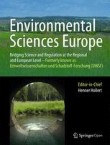Citation Impact 2023
Journal Impact Factor: 6.0
5-year Journal Impact Factor: 6.6
Source Normalized Impact per Paper (SNIP): 1.691
SCImago Journal Rank (SJR): 1.364
Speed 2024
Submission to first editorial decision (median days): 10
Submission to acceptance (median days): 94
Usage 2024
Downloads: 1,762,581
Altmetric mentions: 1,045
Microplastics and nanoplastics: fate, transport, and governance from agricultural soil to food webs and humans
Microplastics (MPs) and nanoplastics (NPs) are pervasive contaminants in agricultural soils, raising concerns over their environmental fate, food chain infiltration, and potential human health impacts. This re...







